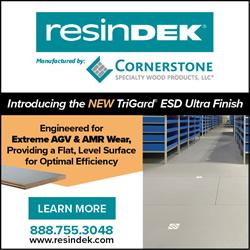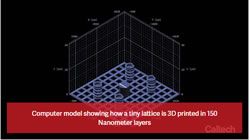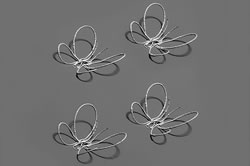Nanotechnology and the future of manufacturing
Nanotechnology involves the manipulation of matter on the atomic and molecular scale - structures between one and 100 nanometres in size. To put that into perspective, comparing a nanometre to a metre is like comparing the size of a marble to the size of the earth. Here Mark Howard, US country manager at automation parts supplier, EU Automation discusses three exciting applications of nanotechnology in manufacturing.
NASA to Advance Unique 3D Printed Sensor Technology
The 3D printing system is like printers used to produce money or newspapers. However, instead of ink, the printer applies nanomaterials, layer-by-layer, onto a substrate to create tiny sensors.
Applications of Nanotechnology in Car Manufacturing
With an increasing demand for vehicle efficiency and efforts to minimize the environmental harm of the automotive industry, the introduction of nanotechnology into the car market is gaining more and more excitement and anticipation.
Organic molecules enable 3D printing of nanoscale metal structures
The Engineer: Researchers at the California Institute of Technology (Caltech) have used a new 3D printing technique to produce complex nanoscale metal structures that are orders of magnitude smaller than previously possible.
Have we solved the nanomaterials problem?
Nick Hall for 3D Printing Industry: Researchers at Virginia Tech have potentially cracked a conundrum that has tormented the scientific community and created a viable method to produce usable metallic nanomaterials. Of course, 3D printing provided the answer and this really could change the world we live in.
Nanostructures have the capacity to disrupt a number of industries and they can revolutionize material science, medicine and battery technology to name just a few. If we can truly harness nanomaterials then almost every facet of modern life will change, from the clothes we wear to our water filtration system. It’s one of those breakthroughs that really could change everything.
So the potential is immense, but nanostructures are complex to produce in usable form. Scaling them up to a workable size has caused issues with the structural integrity, performance and consistency. Outside of the theoretical setting, they have largely frustrated us. Cont'd...
Atomic-scale additive manufacturing techniques could create stronger, lighter, smarter materials
Benedict for 3Ders.org: Researchers at Oak Ridge National Laboratory have predicted that atomic-scale 3D printing techniques could be used to create stronger, lighter, and smarter materials. Focused electron- and ion-based methods could be used to develop quantum computers, efficient solar cells, and other technology.
In a paper published in the journal ACS Nano, ORNL researchers have reviewed several methods of atomic-scale 3D nanofabrication, suggesting ways in which the processes could be refined in order to perfect the art of creating material at the atomic scale. While traditional 3D printers deal with shapes divided into layers which are then turned into physical objects, the process known as “directed matter” involves fabricating structures atom by atom. Scientists believe that this form of additive manufacturing could allow manufacturers of the future to create near-perfect materials with incredibly precise structures. Cont'd...
3D printing of patterned membranes opens door to rapid advances in membrane technology
Penn State Materials Research Institute via Science Daily: A new type of 3D printing developed by researchers at Penn State will make it possible for the first time to rapidly prototype and test polymer membranes that are patterned for improved performance.
Ion exchange membranes are used in many types of energy applications, such as fuel cells and certain batteries, as well as in water purification, desalination, removal of heavy metals and food processing. Most ion exchange membranes are thin, flat sheets similar to the plastic wrap in your kitchen drawer. However, recent work has shown that by creating 3D patterns on top of the 2D membrane surface, interesting hydrodynamic properties emerge that can improve ion transport or mitigate fouling, a serious problem in many membrane applications.
Currently, making these patterned membranes, also called profiled membranes, involves a laborious process of etching a silicon mold with the desired pattern, pouring in the polymer and waiting until it hardens. The process is both time-consuming and expensive, and results in a single pattern type.
“We thought if we could use 3D printing to fabricate our custom-synthesized ion exchange membranes, we could make any sort of pattern and we could make it quickly,” says Michael Hickner, associate professor of materials science and engineering at Penn State. Cont'd...
New dual-step method provides 3D printing of conductive metals.
Shalini Saxena for ArsTechnica: Customizable, wearable electronics open the door to things like heart-monitoring t-shirts and health-tracking bracelets. But placing the needed wiring in a complex 3D architecture has been hard to do cheaply. Existing approaches are limited by material requirements and, in the case of 3D writing, slow printing speeds. Recently, a research team at Harvard University developed a new method to rapidly 3D print free-standing, highly conductive, ductile metallic wires.
The new method combines 3D printing with focused infrared lasers that quickly anneal the printed nanoparticles into the desired architecture. The result is a wire with an electrical conductivity that approaches that of bulk silver. Cont'd...
3D printing software, sensors, and carbon nanotubes among top Advanced Materials trends of 2016
By Kira for 3ders.org: The first month of 2016 is now behind us, and the year is shaping up to be particularly interesting in terms of 3D printing trends. In the advanced materials sector specifically, emerging technologies firmLux Research has predicted that the top three ‘undercover’ advanced materials trends of 2016 include improved 3D printing software and formats, Carbon nanotube products, and IoT devices embedded with sensing materials. Cont'd...
Records 1 to 9 of 9
Featured Product

ResinDek® TRIGARD® ESD ULTRA FOR HIGH-TRAFFIC ROBOTIC APPLICATIONS
To maximize the productivity of an autonomous mobile robot (AMR) or automatic guided vehicle (AGV) deployment, it's critical to create the optimal environment that allows the vehicles to perform at their peak. For that reason, Cornerstone Specialty Wood Products, LLC® (www.resindek.com) created the TriGard® ESD Ultra finish for its ResinDek® engineered flooring panels. The TriGard ESD Ultra finish is ideal for high-traffic robotic applications characterized by highly repetitive movement patterns and defined travel paths.
Manufacturing and Automation - Featured Company

Fronius Perfect Welding
We aspire to produce more than just welding systems, which is why we are the innovation leader for arc welding and are constantly developing welding processes further. In addition to welding technology for robot applications, we offer solutions for manual gas shielded arc welding, for MIG/MAG, TIG, and MMA welding processes. We also implement automated, complete welding solutions tailored to customer requirements in the field of welding automation. After all, welding creates connections - between metals, between industries, and between people. Connected by the arc, by passion, by the beat of welding.









